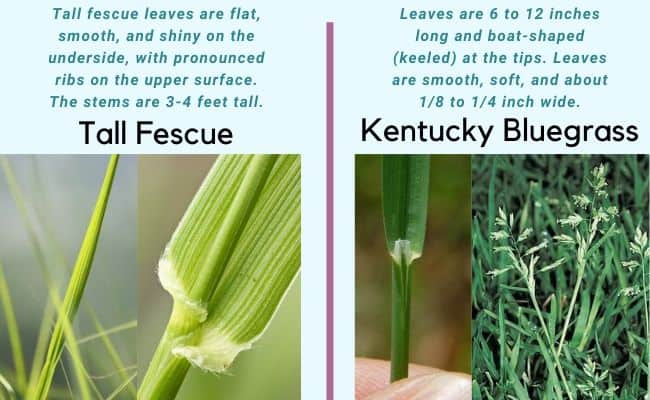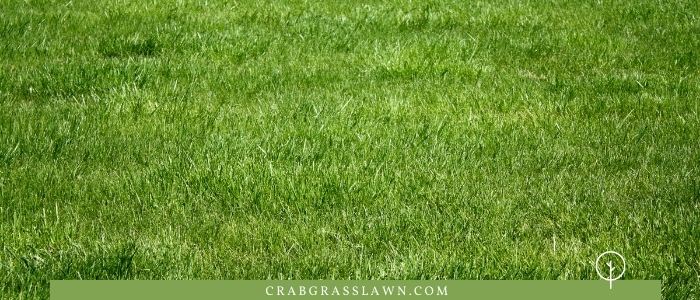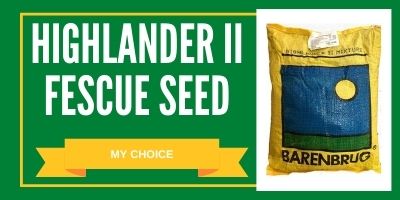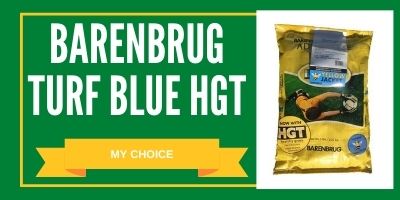Deciding between Kentucky Bluegrass and Tall Fescue for your lawn? While both are cool-season grasses, various unique factors set them apart.
Quick Answer
The main difference between Kentucky bluegrass and tall fescue is the maintenance cost factor and appearance. But they also vary in terms of:
- Fertilizer need
- Watering need
- Traffic resistance
- Heat resistance
- Shade resistance
Let’s delve deeper into the differences between these grass varieties.
Kentucky Bluegrass vs Tall Fescue (Differences)
Since Kentucky bluegrass and tall fescue are both cool-season grasses, these two turfgrass species have various similarities. Still, that doesn’t mean that there are no differences between the two. If anything, there are lots of differences between these two lawn kinds of grass.

Difference between Kentucky Bluegrass and Fescue
Here’s a table that summarizes the differences between Kentucky Bluegrass and tall fescue:
| Differences | Tall Fescue | Kentucky Bluegrass |
| Nitrogen | Tall fescue requires 1 lb of nitrogen fertilizer per 1000 sq. ft. | KBG requires 3 – 6 lbs. of nitrogen per 1,000 sq. ft. |
| Traffic | Develops bunchy sods and is more traffic-resistant. | Forms dense sods but does not tolerate traffic stress as well. |
| Watering | Tall fescure requires only about 1 inch of water every week or 1.5 inches per week when grown in sandy soils. | KBG requires at least 2” of water per week – twice as much of water as Tall fescue. |
| Heat | Is heat-tolerant and resistant to summertime weed invasions and diseases | Vulnerable to weeds and diseases during summer and in generally hot climates |
| Shade | Tall fescues can tolerate moderate shade and require 4 hours of direct sunshine to survive. | KBG tolerates shade but requires at least 8 hours of direct sunshine to survive. |
Which Grass Seed Is Better Kentucky Blue or Tall Fescue?
For Tall Fescue seeds, I personally like the Highlander II Fescue grass seed that you can get here.
For Kentucky Bluegrass seed, I’ve been using Barenbrug’s Turf Blue HGT with Yellow Jacket Coating. This has performed best in almost all climates. Check it out here.
Water requirements
Kentucky bluegrass needs 2” of water per week, and sometimes even 2 ½” per week during the summer, and tall fescue needs at least 1-1.5 inches of water per week. When conditions are hot during summer and there is a lack of rain, your lawn may require even 2 ½” per week.
If your lawn is grown in sandy soils, you may need to apply about ½ inch of water every third day. Here are a few ways to improve sandy soils.
Fertilizer requirements
You’ll need to apply 3 to 4 pounds of nitrogen fertilizer per 1,000 square feet of tall fescue lawn while Kentucky bluegrass is more fertilizer-intensive, requiring an average of 3 to 6 lbs. of nitrogen per 1,000 sq. ft. of lawn, per year.
For both kinds of grass, however, it is important to do a soil test to determine the deficient nutrient before choosing the best fertilizer for your lawn.
It is best to start to fertilize a fescue lawn in March or early April. Do not apply fertilizer after April 15th.
Shade tolerance
Both Kentucky bluegrass and tall fescue grasses can resist a certain amount of shade and still thrive.
However, while tall fescues require 4 hours of direct sunshine per day minimum to survive, Kentucky bluegrass needs at least 8 hours of direct sunlight to grow and thrive. The Glade and Bensun are the most shade-resistant cultivars of Kentucky bluegrass. If you’re trying to establish a lawn in a shady yard, you’d do well to choose tall fescue as your turfgrass.
Traffic tolerance
Moving on- unlike other fescue sub-species – Tall fescue is more traffic-tolerant compared to Kentucky bluegrass, making it suitable for use on grounds that undergo heavy use – such as sports pitches.
Seed germination time
In terms of growth and seed germination, Kentucky bluegrass seeds take longer to germinate in comparison to tall fescue seeds.
Sod formation
Additionally, Kentucky bluegrass forms dense sods that spread out by themselves to cover even bare patches. Tall fescue, on the other hand, develops bunchy sods that eventually require re-seeding to get rid of bare patches in the lawn.
Weeds and growth
The final notable difference is their preferred growing conditions. While Kentucky bluegrass is vulnerable to weeds and diseases during summer and in generally hot climates, tall fescue is rather heat-tolerant and is resistant to summertime disease and weed invasions such as crabgrass.
Tall Fescue Identification + Pictures
What Does Tall Fescue Look Like?
Tall fescue leaves are flat, smooth, and shiny on the underside, with pronounced ribs on the upper surface. The stems are 3-4 feet tall, supporting a nodding panicle that is 4-12 inches long.
Tall fescue – known by the scientific name Festuca arundinacea – is a popular turfgrass species that was introduced into America from Asia and Europe. It thrives in humid temperate regions, where it can grow up to about 16 inches.
It also does well in wet-soil regions and doesn’t require lots of sunshine exposure, hence a good turf grass choice for lawns that already contain other types of flora.
- Despite being a cool-season grass, Tall fescue is known to be more heat, drought, and traffic tolerant than most typical cool-season turfgrass species.
- When grown by itself without mixing in other grass species, Tall fescue grass develops to form rough, bunchy turfs with a lush green appearance.
There now exist hybrid varieties that possess a finer texture and form denser turfs. You can also identify Tall fescue by observing the venation, as the upper side of this grass species’ leaf blades contain longitudinal venation. There are two types of tall fescue that are marketed – temperate and Mediterranean.
Tall fescue grass varieties also spot pointed leaf tips. Meanwhile, the dull appearance of the upper sides of the leaf blades contrasts with the glossy texture on the lower side.
Tall fescue is quite saline-tolerant and can do well in soils with pH levels of between 5.4 and 6.2. It also features an extensive fibrous root system and can form sods through underground shoots (rhizomes).
Tall fescue grass also has smooth, circular flowering stems and is known to lack a definite ligule.
You can identify Tall fescue seeds by their oval shape and tan-brown color. The seeds also have slim, circular rachillas.
Fescue vs Tall Fescue
The words fescue and tall fescue are often used interchangeably but they are two different types of grasses with varying care needs.
- Tall fescue thrives in compact, rich, and moist soil whereas fescue likes sandy and well-drained soils
- Another notable difference between the two types of grasses is the texture of their foliage – Tall fescue has broader leaf blades and is rough in texture compared to fescue.
Does Tall Fescue Spread?
Yes, tall fescue spreads differently through vertical shoots called “tillers. These tillers grow at the base of the tall fescue plant and in clumps, which is why tall fescue is regarded as a bunch-type grass. Tillers are basically new grass shoots that arise from the base of the new grass plants.
Kentucky Bluegrass Identification + Pictures
What Does Kentucky Bluegrass Look Like?
Kentucky Bluegrass leaves are 6 to 12 inches long and boat-shaped at the tips. They appear to be smooth, soft, and about 1/8 to 1/4 inch wide.
The bluegrass video discusses the differences between bluegrass and perennial ryegrass since they are often mixed and look similar.

Kentucky bluegrass – scientifically known as Poa pratensis – typically grows to a height of between 18-24 inches, with a canoe-shaped leaf tip.
During spring, it develops new leaves every ten days, with the duration increasing to about 22 days during summer and fall.
During winter, however, leaf production depends on the region’s climate. In Northern regions, there’s no leaf production in winter, as opposed to transition zones where leaf production doesn’t stop all through the year.
From spring to summer, new leaf blades that appear on Kentucky bluegrass grow up to about 4 inches tall with this length gradually reducing as the year progresses into late summer and fall.
This is because leaf blade length is determined by day length, with the blades able to grow taller during the longer summer days than during the shorter fall days.
The leaf angle also differs by season, with new leaf blades appearing during spring and early summer being erect and those appearing from late summer and fall being decumbent.
Kentucky bluegrass typically develops rhizomes that sprout up from the leaf axils, just above the ground surface. The rhizomes grow downwards into the soil from where they develop and branch out.
During spring and early summer, however, the growing sections at the tip of the rhizomes grow upwards and branch out as above-ground shoots. Kentucky bluegrass rhizomes typically have a two-year lifespan.
FAQs
Is Kentucky 31 the Same as Kentucky Bluegrass?
KY-31 short for Kentucky bluegrass is more shade-tolerant Kentucky bluegrass but is a bunch-type grass just like all tall fescue grasses.
Can I Mix Kentucky Bluegrass with Tall Fescue?
You can mix Kentucky bluegrass with tall fescue at the rate of 1 to 2 lb of each species per 1,000 square feet.
Which Lawn Grass Has the Deepest Roots?
Most turfgrass roots measure between 1 and 2 inches long, but the roots of Bermuda grass can grow up to 8 feet.
Which Grass to Choose
Whether to choose tall fescue or Kentucky bluegrass largely depends on where you live. In the transition zone (the coast of the Atlantic through Kansas), summer days tend to be too hot and arid for Kentucky bluegrass.
Tall fescue, on the other hand, is a heat-tolerant grass species that will definitely thrive in the same region.
Finally, depending on what lawn aesthetic you’re going for, you can also always blend these two cool-season grass species for varied results.
References
- Pennstate College of Agricultural Sciences: Bluegrass, Kentucky
- USDA Plant Guide: TALL FESCUE, Lolium arundinaceum
- USDA Plant Guide Fact Sheet: Kentucky Bluegrass, Poa pratensis L.
Hi, Alex Kuritz here. Growing up I remember that my family had one of the best lawns in the neighborhood. Richly green and lush. I did a lot as I grew up in terms of caring and tending for not only my family’s lawn but also my neighbors. I can say I have years of experience, and I am here to share it with you.





Good expose. Now, please contrast St. Augustine vs. Zoisia. Thanks